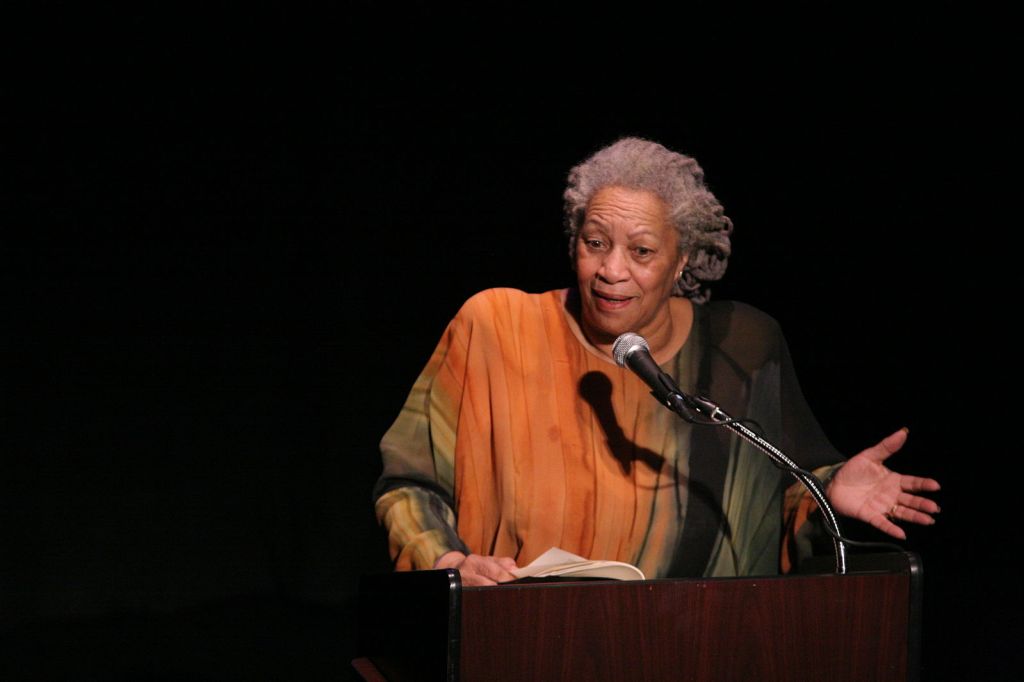In the New Yorker, Zadie Smith argues that Toni Morrison’s only short story, “Recitatif,” is magisterial in how it deals with racial stereotyping and conflict. I agree. It follows two characters, Twyla and Roberta, who spend four months together in a shelter as young girls. One of them is white and one black, but we don’t know which one is which, and as they grow and their paths cross at various points, they grow further and further apart, which reaches a climax at a school protest:
The personal connection they once made can hardly be expected to withstand a situation in which once again race proves socially determinant, and in one of the most vulnerable sites any of us have: the education of our children. Mutual suspicion blooms. Why should I trust this person? What are they trying to take from me? My culture? My community? My schools? My neighborhood? My life? Positions get entrenched. Nothing can be shared. Twyla and Roberta start carrying increasingly extreme signs at competing protests. (Twyla: “My signs got crazier each day.”) A hundred and forty characters or fewer: that’s about as much as you can fit on a homemade sign. Both women find that ad hominem attacks work best. You could say the two are never as far apart as at this moment of “racial strife.” You could also say they are in lockstep, for without the self-definition offered by the binary they appear meaningless, even to themselves. (“Actually my sign didn’t make sense without Roberta’s.”)
Smith argues that to “admit a shared humanity,” the two characters need to reexamine “a shared history”:
Such reëxaminations I sometimes hear described as “resentment politics,” as if telling a history in full could only be the product of a personal resentment, rather than a necessary act performed in the service of curiosity, interest, understanding (of both self and community), and justice itself. But some people sure do take it personal. I couldn’t help but smile to read of an ex-newspaper editor from my country, who, when speaking of his discomfort at recent efforts to reveal the slave history behind many of our great country houses, complained, “I think comfort does matter. I know people say, ‘Oh, we must be uncomfortable.’ . . . Why should I pay a hundred quid a year, or whatever, to be told what a shit I am?” Imagine thinking of history this way! As a thing personally directed at you. As a series of events structured to make you feel one way or another, rather than the precondition of all our lives?
Smith is right and wrong here. She’s right that an honest reckoning with history — especially America’s history of slavery — is a prerequisite for creating a functioning community. She goes on to write that “Some take the narrowest possible view of this category of ‘my people’: they mean only their immediate family. For others, the cry widens out to encompass a city, a nation, a faith group, a perceived racial category, a diaspora. But, whatever your personal allegiances, when you deliberately turn from any human suffering you make what should be a porous border between ‘your people’ and the rest of humanity into something rigid and deadly.” Hear, hear, Aristotle’s remarks on one’s duty to people most proximate aside.
But the problem is that the reckoning with history we see at present — in things like the New York Times’s 1619 Project, for example — is anything but honest. The ex-newspaper editor Smith cites (it is Charles Moore, former editor of the Daily Telegraph and the Spectator) is right that the point of such retellings is very much to show that all white people are “shit.”
In the latest issue of First Things, Helen Andrews reviews Nikole Hannah-Jones’s The 1619 Project: A New Origin Story, and that agenda becomes clear. Andrews writes:
In the two years since its initial publication in the New York Times, the scholarly rebuttal to the 1619 Project has focused on its two biggest departures from the academic consensus: the claim that the American Revolution was motivated by the colonies’ desire to preserve slavery, which no less an eminence than Gordon S. Wood has refuted, and the claim that American capitalism was built on the wealth generated by slavery, which has been energetically attacked by economic historians such as Phil Magness.
These expert refutations, however essential, will not touch the 1619 Project’s central thesis: that racial minorities are what America is about. This is not a one-time rebalancing of the attention history books give to various demographics. It is a sweeping principle of infinite application, not just to America’s history but to its future.
Smith concludes by suggesting that the point of these racial reckonings is to move beyond race itself: “Race, for many, is a determining brand, simply one side of a rigid binary. Blackness, as Morrison conceived of it, was a shared history, an experience, a culture, a language. A complexity, a wealth. To believe in blackness solely as a negative binary in a prejudicial racialized structure, and to further believe that this binary is and will forever be the essential, eternal, and primary organizing category of human life, is a pessimist’s right but an activist’s indulgence.”
Perhaps Smith has both Hannah-Jones and Ibram X. Kendi in mind here. They have both made blackness their brand and have done very little, as John McWhorter argues in his latest book, to improve the lives of black people in any way.
In other news
The “new moralism” in anthropology is not a good thing, Nicolas Langlitz argues:
Since the late 20th century . . . the shift from the savage slot to what Robbins calls “the suffering slot” has been accompanied by the rise of a new moralism: “Premised on the universality of trauma and the equal right all human beings possess to be free of its effects, suffering-slot ethnography is secure in its knowledge of good and evil and works toward achieving progress in the direction of its already widely accepted models of the good,” as Robbins puts it. As witnesses of the world’s most arresting ills, anthropologists must call out whoever or whatever is to blame. Of course, these knights in shining armor will repentantly recognize their own complicity with the structures of oppression, demand that we move beyond these structures, and come out morally elevated. As an anthropologist of science, however, I can’t help wondering how telling good from bad has become such a pervasive practice. Shouldn’t anthropologists be primarily concerned with telling true from false? I am looking for ways of writing about human beings that do not mobilize the readers’ empathy with one group at the expense of their empathy with another group. Is it really necessary for anthropologists to regularly tempt readers already struggling to abstain from self-righteousness? Why dangle in front of them identification with an author who denounces, and thereby elevates his readers above, racists, sexists, capitalists, neoliberals, imperialists, neocolonialists, and scientists whose naturalist worldviews cement an unjust status quo?
Molière will not be inducted into the Panthéon: “The reason, according to President Emmanuel Macron’s cultural adviser, Stéphane Bern, was simple: The Panthéon, he declared, was reserved for republicans. ‘Opening the Panthéon to the father of the French language,’ Bern observed, ‘is a nice idea.’ But nice is not enough. The Panthéon, Bern noted, seeming to state the obvious, honors ‘only those who have defended the republic. In other words, great men and women who come after the Revolution.’ This is an odd claim.”
Is the CD revival finally here? Rob Sheffield thinks it is.
Adam Kirsh writes about W.E.B. Du Bois’s love of Wagner and the time he attended the Bayreuth Festival in 1936, “when it was closely associated with the Nazi regime”:
Writing about the experience in his essay “What of the Color-Line?,” Du Bois acknowledged the moral complications involved, noting that on his daily walk he passed the former home of Houston Stewart Chamberlain, Wagner’s son-in-law, who “did more perhaps than any one to establish in Germany the theory of Nordic superiority.” Chamberlain’s racist, anti-Semitic opus The Foundations of the Nineteenth Century was an important influence on Hitler, and Cosima Wagner, the composer’s widow, had been one of the führer’s crucial early supporters. Yet Du Bois writes admiringly about her and describes Bayreuth as a shrine to “the spirit of Beauty,” comparing it to Chartres Cathedral. As for Wagner’s operas, he has no doubt about their humanity and universality: “No human being, white or black, can afford not to know them, if he would know life.” If Du Bois wasn’t deterred by Nazi Bayreuth, it was partly because he had a lifetime of experience separating the treasures of the human spirit from the institutions that administered them. For John Jones, the fact that a racist opera house was the only place to hear Lohengrin didn’t mean that the opera itself was tainted. On the contrary, the music was the best critique of the barbarism that surrounded it.
David Pryce-Jones reads Henry “Chips” Channon’s diaries and notes “the more you read of Chips, the less likeable he becomes.”
Resurrecting the secularization thesis: In his review of Secular Surge: A New Fault Line in American Politics, John J. DiIulio, Jr. writes:
[A] funny thing happened on the way to global secularization: namely, it didn’t happen. In 1996, writing in the National Interest, Berger flatly acknowledged that the secularization theory of the 1950s and 1960s had been “essentially mistaken.” What happened instead was what Berger, in the title of a 1999 edited volume, called The Desecularization of the World. In 2006, at the Pew Forum’s biannual Faith Angle Conference on religion, politics, and public life, Berger referred to our age as one of “overwhelming religious globalization” . . . In Secular Surge: A New Fault Line in American Politics, three of the most widely respected empirical researchers in the field of social science—Notre Dame’s David E. Campbell and Geoffrey C. Layman, and the University of Akron, Ohio’s John C. Green—offer a brilliantly researched and carefully reasoned argument for reconsidering secularization theory, based on their groundbreaking research in the United States. In the end, though, they do not succeed in resurrecting the theory.
Jeet Heer wonders if Terry Teachout is the last conservative critic. It’s not a very interesting question, and the answer is no.


















